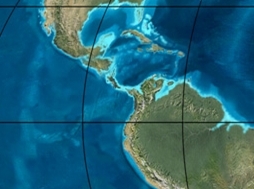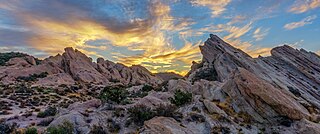The Birdrong Sandstone is an Early Cretaceous geologic formation of the Barrow Group in Western Australia. Dinosaur remains are among the fossils that have been recovered from the formation, although none have yet been referred to a specific genus.

The Castillo Formation is an Early Miocene geologic formation in the Falcón Basin of Venezuela. The formation unconformably overlies the Matatere, Misoa, El Paují and Jarillal Formations. The Castillo Formation is overlain by Quaternary alluvium and in places by the Capadare Formation. The formation, deposited in a calm near-shore lagoonal brackish environment, with possibly fluvial influence, has provided a rich assemblage of fossil crocodylians, turtles, giant sloths and various types of fish.
The Lagarcito Formation is an Albian geologic formation in Argentina. Pterosaur fossils have been recovered from the formation. The formation overlies the La Cruz Formation and is overlain by the San Roque Formation. The sandstones and mudstones of the formation were deposited in a fluvial and mostly lacustrine environment. The fossil association and the geological evidence indicate that the Lagarcito Formation represents a perennial shallow lake situated in an alluvial plain where detrital sedimentation and semiarid climatic conditions predominated.
The Runningwater Formation is a geologic formation in Nebraska. It preserves fossils dating back to the Hemingfordian of the Early Miocene of the Neogene period. The sandstones and conglomerates of the formation were deposited in a fluvial environment. The formation has provided many fossil mammals.
The Goliad Formation (Tg) is a geologic formation in Texas. It preserves fossils dating back to the Serravallian to earliest Pliocene stages of the Neogene period, including the gomphothere Blancotherium among many other fossil mammals, reptiles, birds and fish.

The Wasatch Formation (Tw) is an extensive highly fossiliferous geologic formation stretching across several basins in Idaho, Montana Wyoming, Utah and western Colorado. It preserves fossils dating back to the Early Eocene period. The formation defines the Wasatchian or Lostcabinian, a period of time used within the NALMA classification, but the formation ranges in age from the Clarkforkian to Bridgerian.

The Galisteo Formation is a geologic formation in New Mexico. It contains fossils characteristic of the Bartonian stage of the Eocene epoch, Duchesnean in the NALMA classification.
The Plush Ranch Formation is a geologic formation in the Transverse Ranges of southern California. The formation preserves fossils dating back to the Late Oligocene to Early Miocene.

The Punchbowl Formation is a sedimentary sandstone geologic formation in the northern San Gabriel Mountains, above the Antelope Valley in Los Angeles County, southern California.
The San Francisquito Formation is a geologic formation in northern Los Angeles County, California.
The Diligencia Formation (Td) is a geologic formation cropping out in the Orocopia Mountains in southern California. It preserves mammal fossils dating to the Late Oligocene to Early Miocene.
The Tick Canyon Formation (Tt) or Tick Canyon strata, is an Early Miocene geologic formation in the Sierra Pelona Ridge of the San Gabriel Mountains in Los Angeles County, California.
The Coalspur Formation is an Upper Cretaceous to lower Palaeocene stratigraphic unit of the Western Canada Sedimentary Basin in the foothills of southwestern Alberta. Its deposition spanned the time interval from latest Cretaceous (Maastrichtian) to early Palaeocene, and it includes sediments that were deposited before, during, and after the Cretaceous-Paleogene (K-Pg) extinction event. It includes the economically important coal deposits of the Coalspur Coal Zone, as well as nonmarine plant and animal fossils.
The Gracias Formation is a geologic formation in Honduras. The mainly sandstones, siltstones and claystones preserve vertebrate fossils dating back to the Neogene period.
The Castilletes Formation is a fossiliferous geological formation of the Cocinetas Basin in the northernmost department of La Guajira, Colombia. The formation consists of fossiliferous mudstones, siltstones and medium-grained to conglomeratic fossiliferous lithic to quartzitic sandstones. The Castilletes Formation dates to the Neogene period; Burdigalian to Langhian stages, Colloncuran and Friasian in the SALMA classification, and has a maximum thickness of 440 metres (1,440 ft).
The Elisabeth Bay Formation, alternatively spelled as Elizabeth Bay Formation, is an Early Miocene geologic formation in the Sperrgebiet, ǁKaras Region of southwestern Namibia, overlying the Blaubok Conglomerate. The freshwater green and red siltstones, sandstones, intercalations of conglomerates and claystones of the formation were deposited in a fluvial environment, infilling a paleovalley incised during the Oligocene low sea stand, which backfilled during the Burdigalian marine transgression. The Elisabeth Bay Formation provides many fossil mammals, snakes and other reptiles.
The Onzole Formation is an Early Pliocene geologic formation in the Borbón Basin of northwestern Ecuador. The formation consists of a shallow marine sandstone member containing many fish fossils, among which megalodon, and a deep water member comprising tuffaceous shales and mudstones containing gastropods, bivalves and scaphopods.

The Dorotea Formation is a geological formation in the Río de Las Chinas Valley of the Magallanes Basin in Patagonian Chile whose strata date back to the Campanian to Maastrichtian of the Late Cretaceous.

The Vasquez Formation (Tvz) is a geologic formation cropping out at the eponymous Vasquez Rocks in southern California. The formation dates to the Late Oligocene to Early Miocene.
The Yalvaç Basin is a sedimentary basin in Turkey, around Lake Beyşehir and the present-day town of Yalvaç. It lies within the geological region known as the Isparta Angle. It has existed since Miocene times.








